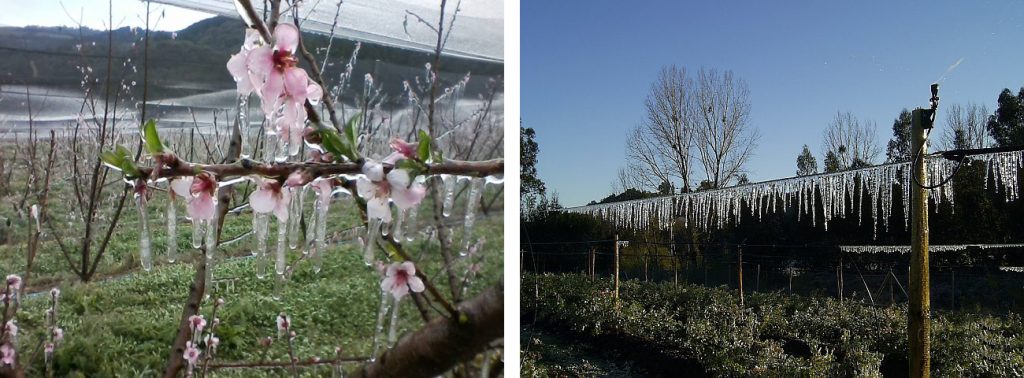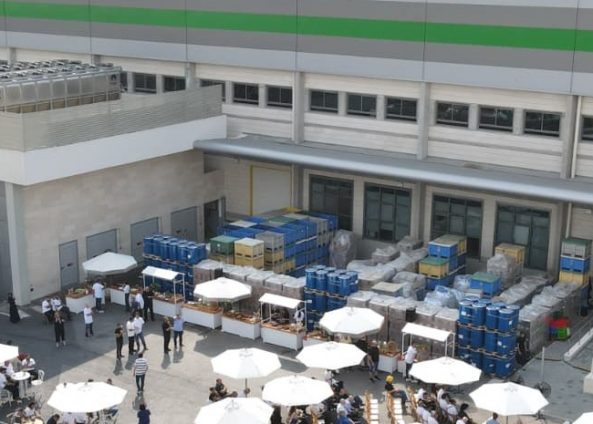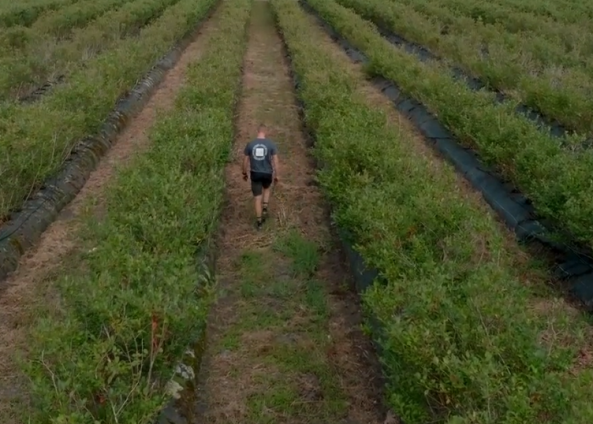
Frost Control Through Sprinkler Irrigation: Protecting Your Crops from Seasonal Chills
Frost control is a critical concern for farmers, especially during late spring or early winter when crops are most vulnerable. Sprinkler irrigation systems can be highly effective in protecting crops from frost damage by leveraging the release of latent heat during the freezing process. As water freezes around the crops, it releases a small amount of heat and at the same time creates a protective layer of ice at a temperature that is not risky for the crops. This ice acts as an insulating blanket, maintaining temperatures above the crop freezing point and prevents damage to delicate plant tissues. This method is widely used for crops like fruit trees, vineyards, and other sensitive crops. Learn more in our Introductory Guide to Protecting Your Investment from Frost.
Understanding Frost Types and Their Impact
To effectively combat frost damage, it’s essential to understand the two main types of frost that can affect crops. For a deeper look at the types of frost and how they form, visit our Knowledge Hub.
1. Radiation Frost
Radiation frost typically occurs on clear, calm nights when the ground loses heat rapidly during the night due to infrared radiation being emitted into the clear sky. This type of frost typically forms under specific weather conditions, such as clear skies and calm winds. The lack of wind means the cold air is not mixed, causing temperatures near the surface to drop rapidly. As the air temperature plummets, ice forms on plant surfaces, leading to frost damage. This type of frost can be severe in areas with little wind and clear skies. While sprinklers can offer protection in certain conditions, advection frost often requires active frost protection methods like irrigation to mitigate crop damage.
2. Black Frost
Black frost occurs during a thermal inversion, where a layer of warmer air traps cold air near the ground, preventing proper mixing of the atmosphere. This phenomenon can happen on clear or cloudy nights and may be accompanied by light winds. The cold air near the ground can lower temperatures enough to freeze plant tissues, even when air temperatures at higher altitudes are not particularly low. Black frost can be difficult to prevent with sprinkler irrigation because the temperature inversion traps the cold air close to the ground. It’s a challenging scenario for frost protection, requiring other techniques.
How Irrigation Prevents Frost Damage
Irrigation offers a highly effective method of frost protection by using water to generate latent heat. When water is applied before frost is expected, it freezes around the plants, forming a protective transparent ice layer. As the water freezes, it releases heat, which helps maintain the temperature of the plants just above the crop freezing point. This technique is based on the principle of latent heat, where the energy released during the freezing process helps keep crops warm enough to avoid frost damage. Sprinkler systems that provide consistent, even coverage is essential to ensure the ice layer forms correctly around the plants, preventing cold-induced harm.
Choosing the right frost protection solution for your crops depends on your climate and crop sensitivity. Make sure your system is built for the conditions you’re facing.
Choosing the Right Irrigation System
Selecting the right irrigation system for frost protection is crucial and depends on several factors, including crop type, field layout, water availability, and the desired temperature for protection. There are several methods available, such as full canopy coverage, under-tree mitigation, individual sprinkler systems for each tree (targeted system) or the strip system. The chosen system must deliver enough water to generate the necessary latent heat while also being efficient in terms of water usage. For example, sprinkler systems like Rivulis’ AquaSmart 2002 and Rondo are well-suited for frost protection, offering both flexibility and efficiency in maintaining optimal conditions for crops during frosty periods.
Now is the time to double-check your irrigation setup and make sure your crops are protected from frost before the next cold snap.
Sprinklers located under the trees
For orchards and fruit tree plantations, positioning sprinklers under the trees provides an effective method of frost mitigation. This approach uses sprinklers like the Rivulis AquaSmart 2002 or Rondo, which can handle both irrigation and frost protection. By applying water at the base of the tree, the system ensures that the freezing water surrounds the tree’s lower layers, helping to maintain temperatures in the orchard above the crop freezing point. While effective in moderate frost conditions, this method has limitations at temperatures below -2°C, so it is best used in areas where frost severity is less extreme. It is a cost-effective solution for many growers.
Full above-canopy coverage
Full above-canopy coverage provides a comprehensive approach to frost protection by using sprinklers placed over the entire canopy of the crop. This method ensures uniform water distribution across the entire field, protecting every plant in the area. Sprinklers like the Rivulis 233B or Super 10 are often used for overhead coverage, as they provide high application rates that can combat frost effectively. Full coverage is particularly valuable when large areas need protection, as it prevents blind spots and ensures no plant is left exposed. However, this method requires more water and may be less efficient than more targeted approaches like individual protection or strip methods.
Individual sprinkler system for each tree
An individual sprinkler system for each tree offers precise and targeted frost protection, ensuring that water is applied only where needed. This system uses micro-sprinklers positioned above each tree, delivering water in a controlled manner to create a protective layer of ice around the tree’s critical parts. The targeted water application minimizes water waste and ensures that each tree receives adequate protection, even in less severe frost conditions. This method is highly water-efficient and ensures that each tree, rather than the entire field, receives the necessary protection.
The strip method
The strip method is commonly used for row crops like vineyards and orchards, where narrow, continuous strips of land need protection from frost. This technique uses specialized sprinklers like the Rivulis Flipper, which delivers targeted coverage to the rows, ensuring that only the areas requiring frost protection are watered. The strip method is highly efficient in terms of water usage, as it avoids wetting areas between rows. This method is particularly beneficial in vineyards, where precise control over frost protection is needed. While effective, it requires careful planning and installation to ensure the correct spacing and distribution for optimal frost control.






